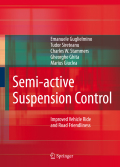
Semi-active suspension control: improved vehicle ride and road friendliness
Guglielmino, E.
Sireteanu, T.
Stammers, C.W.
Ghita, G.
Semi-active Suspension Control provides an overview of vehicle ride control employing smart semi-active damping systems. These systems are able to tune theamount of damping in response to measured vehicle-ride and handling indicators. Two physically different dampers (magnetorheological and controlled-friction) are analysed from the perspectives of mechatronics and control. Ride comfort, road holding, road damage and human-body modelling are studied. Mathematical modelling is balanced by a large and detailed section on experimental implementation, where a variety of automotive applications are described offering a well-rounded view. The implementation of control algorithms with regard to real-life engineering constraints is emphasised. The applications described include semi-active suspensions for a saloon car, seat suspensions for vehicles notequipped with a primary suspension, and control of heavy-vehicle dynamic-tyreloads to reduce road damage and improve handling. Describes the control of semi-active suspension which is more effective than traditional and widely-covered passive suspension and much cheaper than very specialised active suspensionCompares the behaviour of magnetorheological dampers, already on the market, with that of friction dampers still under development Shows the reader how thehuman body reacts to vibration and the benefits of different damping regimes INDICE: Introduction.- Dampers and Vehicle Modelling.- Human Body Analysis.- Semi-active Control Algorithms.- Friction Dampers.- Magnetorheological Dampers.- Case Studies.
- ISBN: 978-1-84800-230-2
- Editorial: Springer
- Encuadernacion: Cartoné
- Páginas: 310
- Fecha Publicación: 01/07/2008
- Nº Volúmenes: 1
- Idioma: Inglés
